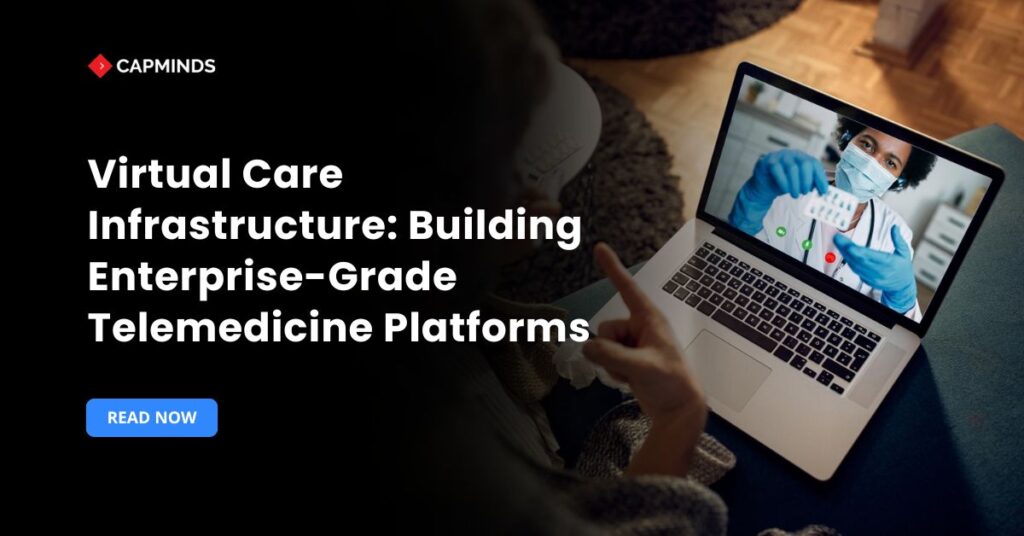Virtual Care Infrastructure: Building Enterprise-Grade Telemedicine Platforms
Modern healthcare systems increasingly view virtual care as a strategic imperative. Enterprise telemedicine can extend care access, improve outcomes, and advance the “quadruple aim” (better outcomes, better patient and clinician experience, lower costs) by tightly integrating virtual visits into the care delivery model. Yet to realize these benefits, healthcare organizations must invest in a robust underlying infrastructure.
As one expert review notes, modern telemedicine architectures emphasize security, interoperability, and scalability as critical success factors. In other words, a successful enterprise-grade platform must be designed for growth, data exchange, and protection from the start.
Building a future-ready telehealth infrastructure also pays strategic dividends.
- For example, a telehealth platform closely integrated with electronic health records (EHRs) and quality data streams can directly support value-based care initiatives.
- Conversely, poor execution can undermine trust and usage: research shows that if the user experience is clunky, patients and providers simply “drop off” and abandon the system.
- In practice, this means healthcare IT leaders should treat virtual care not as an add-on, but as a core service line requiring enterprise planning.
A strong virtual care infrastructure enables new care models across all sites, which in turn drives improved access, equity, and operational efficiency in the long term.
1. Scalability and Performance
Scalability is fundamental: an enterprise platform must handle surges in demand without compromising quality. This means supporting potentially thousands of simultaneous video visits, data streams, and integrations.
As COVID‑19 demonstrated, virtual care usage can spike unexpectedly; the platform must elastically scale (up and down) while preserving performance.
- Key technical strategies include cloud-based or hybrid architectures, microservices, containerization, and automated load balancing.
- For example, deploying telehealth services on a scalable cloud infrastructure allows dynamic resource allocation during peak usage, while hybrid models can integrate on-premises assets for specialized needs.
To ensure high performance at scale, healthcare IT teams should consider the following best practices:
Cloud or Hybrid Infrastructure
Leverage cloud platforms for elastic scale and disaster recovery. A hybrid model can localize sensitive workloads (e.g., within hospital data centers) while bursting to the cloud for additional capacity.
Load Balancing & Microservices
Architect the platform using stateless services, containerized microservices, and API-based modules. This enables traffic to be evenly distributed and individual components (e.g., video streaming, patient scheduling, EHR interface) to scale independently.
Capacity Planning
Perform regular load testing and capacity modeling. Plan for peak scenarios (e.g., flu seasons or pandemics) with redundancy. Continuously monitor usage metrics to trigger autoscaling or add resources proactively.
Network Quality and Devices
Ensure high-speed, redundant connectivity at all sites. As one expert notes, “high-volume telemedicine requires appropriate infrastructure including high-speed internet connectivity and camera and microphone-enabled devices,”.
Investing in network upgrades (fiber, private links) and standardized video equipment prevents bottlenecks and poor call quality under heavy load.
By designing for scalability from day one, an organization avoids costly re-architectures later. A well-scaled platform can grow organically with demand, supporting more specialties, geographies, or care models, without disrupting existing services.
2. Interoperability and Data Exchange
Interoperability is the glue that makes virtual care enterprise-ready. Telemedicine platforms must seamlessly exchange data with EHRs, scheduling systems, imaging archives, and other clinical systems. Without robust data integration, virtual visits become data gaps, undermining clinician workflow and care continuity. At the enterprise level, interoperability challenges are magnified: multi-hospital networks often have heterogeneous EHRs and legacy applications that speak different “dialects.”
For instance, one advisor points out that hospitals may use “various standards” and implement them inconsistently, which creates major data quality gaps.
To address this, enterprise telehealth initiatives should:
Adopt Common Standards
Embrace industry standards like HL7 FHIR for clinical data exchange and DICOM for imaging. Standardized APIs and data formats are essential for sharing patient records, labs, and images across systems. The proposed TEFCA framework in the U.S. further encourages standard APIs for cross-organization queries. Encouraging all facilities in the network to use the same data standards reduces translation overhead.
Use Integration Engines/Middleware
Deploy an interoperability platform or interface engine that can translate between diverse data formats. Middleware can broker between different EHRs or lab systems, ensuring that a telemedicine consultation record can flow to any downstream system. This “middleware approach” minimizes point-to-point integrations and isolates complexity.
Implement Robust APIs
Wherever possible, use modern RESTful APIs and web services for data exchange rather than proprietary interfaces. Cloud-based API gateways and FHIR servers can centralize access to patient data and support new app development.
Data Governance and Quality
Establish data governance policies and master data management. Consistently define patient and provider identifiers, data entry rules, and code sets across all facilities.
Invest in data cleaning and terminology services so that information collected during a virtual visit (e.g., diagnoses, vitals) can be correctly interpreted by any consuming system.
These strategies help organizations “break down data silos” and provide clinicians with a unified view of the patient. Interoperability also reduces clinical risk: for example, if a patient has an allergy noted in the EHR, that alert should surface during a virtual prescription encounter.
Recent research emphasizes that integrating new technologies like FHIR can significantly improve interoperability in telemedicine architectures. In short, enterprise telehealth is only as good as the data ecosystem it plugs into; investing in standards and interfaces is non-negotiable for a multi-site rollout.
3. Security, Privacy, and Compliance
Security and compliance form the backbone of any healthcare IT system, and virtual care is no exception. At enterprise scale, an insecure telemedicine platform can expose protected health information across hundreds of providers and thousands of patients. U.S. healthcare regulations demand rigorous safeguards. All data in transit must be encrypted end-to-end, and data at rest must reside on secure servers with controlled access.
Identity verification and strong authentication are essential to prevent unauthorized access. As HHS guidance emphasizes, even if technology vendors claim compliance, they are treated as Business Associates under HIPAA and must sign agreements and meet all security requirements.
Key security and compliance measures include:
End-to-End Encryption
Use encrypted channels for live video and encrypted storage for records. Many telehealth breaches result from misconfigured video tools; ensure encryption keys are managed securely so that even vendors cannot decode PHI without proper authorization.
Access Controls & Auditing
Implement role-based access control so only authorized staff can initiate or view a virtual visit. Maintain detailed audit logs of all telehealth activity. Automated alerts should flag suspicious behavior.
Business Associate Agreements
Require all technology partners to sign HIPAA-compliant BAAs. Remember that large cloud providers often have standardized BAAs, so review them carefully to ensure they meet your policies.
Security Risk Analysis
Perform regular risk assessments of the telemedicine infrastructure, especially if it integrates directly with the EHR. HHS recommends using official tools (e.g., ONC’s Security Risk Assessment Tool) to evaluate new telehealth setups.
Physical & Operational Safeguards
Secure the clinic and data center equipment physically. Train staff on HIPAA protocols specific to virtual care (e.g. patient identity verification during a video call, using headphones in shared spaces, etc.). Have documented policies for incident response and breach notification.
Because virtual care often crosses state lines and uses new modalities (mobile apps, remote devices), compliance can be complex. Providers should be aware that “no two states are identical in how they define and regulate telemedicine”.
State laws may impose additional privacy requirements or dictate cross-state consent and licensure. For example, some states consider a non-secure phone line exempt from HIPAA, while others may have stricter rules on digital PHI. A proactive compliance program will track these variances and update protocols.
By embedding security into the platform (not as an afterthought), organizations build trust with patients and clinicians. Patients feel reassured seeing visible privacy cues (e.g., disclaimers, encryption indicators), and providers can focus on care instead of worrying about data leaks.
Ultimately, rigorous security is a strategic enabler: it allows scaling virtual care confidently across the enterprise without risking fines or reputation damage.
4. User Experience and Accessibility
User experience (UX) is often the make-or-break factor for telemedicine adoption. A seamless UX encourages both patients and clinicians to embrace virtual visits, whereas clunky interfaces lead to frustration.
Experts warn that “90% of users abandon apps after a bad user experience,” and in telehealth specifically, “if the UX is poor, patients will drop off… usability is one of the biggest reasons why people don’t stick with digital health tools”. Thus, UX design must be a top priority in enterprise platforms.
Key considerations for UX in enterprise telemedicine include:
Intuitive Interfaces
The video visit workflow should be as simple as a phone call. Patients shouldn’t struggle to download software or configure settings at visit time. Clear, step-by-step guidance (pre-call checks for camera/microphone, simple meeting links, and minimal logins) can dramatically reduce no-shows.
For example, integrating “pre-call diagnostics” to verify device compatibility before the actual appointment can prevent last-minute failures.
Device and Accessibility Support
Ensure the platform works on common devices (smartphones, tablets, laptops) and browsers. Incorporate accessibility features like closed captioning, screen reader compatibility, and multilingual support. This widens access, particularly for patients with disabilities or limited tech skills.
Workflow Consistency
Align the telehealth UI with clinician workflows. Clinicians should have a unified console showing schedules, patient information, and documentation tools. Embedding the video visit within the EHR (so the doctor doesn’t toggle between systems) preserves focus and reduces clicks.
Trust Cues
Design the UI to visibly reinforce security. Showing a “HIPAA-compliant” badge, requiring explicit consent, and reminding users about encryption can build confidence.
As one telehealth UX expert notes, patients need to “see and feel that their data is being handled with care”. Simple elements like a privacy lock icon or on-screen privacy disclaimers make the digital experience feel more professional.
Patient-Centric Features
Offer features that enhance care, such as easy upload of photos or vitals before the call, in-call chat for sending links/documents, and post-visit care plans or follow-up reminders. Engaging patients beyond the visit (via secure messages or outcome surveys) extends the platform’s value.
Continuous Feedback Loop
Solicit feedback from users regularly and iterate. Track user satisfaction scores and technical issues. Engage clinician champions to identify pain points. Over time, fine-tuning the UX will prevent “drop off” and sustain engagement.
In a multi-facility setting, consistency is key: a patient or doctor should have a nearly identical experience regardless of location. Training programs and quick-reference guides help internal users adapt.
With a well-designed interface and thoughtful features, virtual care can feel almost as “human” as an in-person visit, driving utilization and positive outcomes in the enterprise.
5. Clinical Workflow Integration
A virtual care platform must integrate smoothly into clinical workflows to avoid creating extra work or gaps. This means embedding telemedicine tasks into daily routines and health IT systems. For example, scheduling a virtual visit should be no more complicated than booking a clinic appointment.
Ideally, appointments booked in the EHR portal should automatically generate a telehealth session link and include pre-visit instructions for patients. After the visit, documentation and billing should be as straightforward as for an office visit.
Essential elements of workflow integration include:
EHR and Schedule Integration
Link the telehealth system with the master schedule and patient record. When a clinician starts a virtual encounter, the patient’s chart should appear automatically.
Likewise, visit notes and orders should flow back into the EHR without dual data entry. Some enterprises use single sign-on (SSO) so providers enter one portal to access charts and start calls. This tight integration was highlighted as a top factor by leaders in telehealth implementation.
Consistent Processes
Define clear protocols for virtual care: who handles triage, how consents are recorded, how billing codes are applied, etc. Train clinical staff on these protocols.
For instance, a nurse may need to verify patient identity and connectivity before handing off to the physician. Having standardized workflows reduces confusion, especially when scaling across sites.
Decision Support and Ancillaries
Integrate clinical decision support into telehealth. For example, if a patient reports symptoms, the clinician can order labs or imaging through the same virtual interface.
Connecting to e-prescribing systems, remote monitoring devices, or e-referral networks ensures care is continuous. If certain telehealth visits require interpreters or in-home services, those should be coordinated within the platform’s workflow.
Documentation and Follow-up
Build templates for telehealth notes and after-visit summaries. Automated reminders (e.g., for follow-up tests or next appointment) keep patients on track. Coordinating virtual and in-person care (like scheduling the next in-office check-up) should be seamless, reflecting in the patient’s overall care plan.
By deeply embedding telemedicine into everyday practice, enterprises prevent it from remaining an “island” of care.
Successful programs train clinicians to deliver the same level of care virtually as in person, following the same guidelines. Over time, this approach makes virtual visits feel like a routine part of care delivery rather than an optional add-on.
Challenges in Multi-Facility Enterprises
Rolling out telehealth across a large hospital network or multi-clinic group introduces unique hurdles. Different facilities may have their legacy systems, IT teams, and even cultures. Here are some enterprise-specific challenges:
System Heterogeneity
Each facility might use a different EHR or ancillary system. Maintaining multiple interfaces and ensuring feature parity across sites is complex. For example, one hospital may accept only a certain lab interface, while another uses a different ordering system. Over time, this can create inconsistent patient experiences unless harmonized. Establishing a central integration strategy is crucial.
Variable Digital Readiness
Facilities may differ in bandwidth, hardware, or IT support. A rural clinic might struggle with unreliable internet, whereas the main campus has dedicated fiber.
The enterprise must account for this by, for example, providing cellular backup at remote sites or standardized telehealth kits. Change management and training also vary: smaller clinics may need more support and encouragement to adopt new workflows.
Regulatory and Licensing Differences
If the network spans states, providers must comply with each state’s telemedicine laws. This includes physician licensure, prescribing rules, and telehealth consenting requirements.
For example, one state might require explicit verbal consent, while another has different mental health telemedicine rules. The IT solution must flag or enforce these rules.
Data Governance Complexity
Centralized governance can clash with local autonomy. Larger systems tend to want standardized data practices for analytics and reporting, but individual facilities may have customized workflows.
Balancing this requires clear policies: define which systems or data fields are mandatory enterprise-wide and which can be locally adjusted.
Security and Privacy Variability
Different sites may have different security postures (some may have more mature IT security teams). Ensuring a uniform security baseline (e.g., all sites using VPN, up-to-date antivirus, etc.) is more challenging at scale. A breach at one small clinic can affect the whole network’s compliance status.
Overcoming these challenges requires strong leadership and coordination.
Many large health systems form a cross-facility steering committee for telehealth, with representation from IT, clinical leadership, compliance, and operations. This body can set enterprise-wide standards while allowing local teams to address site-specific issues.
For example, a central telehealth office might provide a common platform and training, but each clinic can customize appointment types or integration points as needed.
Best Practices and Strategic Insights
For long-term success, building a virtual care infrastructure should be approached as a strategic transformation, not a one-off project. Key best practices include:
Strong Governance
Create a dedicated governance team or center of excellence. This team sets strategy, oversees vendor contracts, defines KPIs, and ensures regulatory compliance. It should include CIOs, CMIOs, compliance officers, and clinicians who champion virtual care.
Vendor and Technology Evaluation
Use a rigorous selection process. Evaluate telemedicine solutions for the five core needs: scalability, interoperability, security, UX, and workflow fit. Insist on vendor transparency for security and support multi-tenant enterprise deployments. Require vendors to provide APIs and demonstrate HIPAA compliance as non-negotiable.
Incremental Rollouts
Pilot new telemedicine programs before full scale. Gather feedback on what worked and what didn’t. Then apply lessons to wider rollout. For example, start with one department or service line, refine the workflows, then expand platform capabilities gradually.
Training and Change Management
Invest in comprehensive training for all user roles: providers, nurses, schedulers, and even patients. Real-time technical support during the early stages builds confidence.
Encourage providers to find “telehealth champions” who can help colleagues. Emphasize that telemedicine appointments should meet the same care standards as in-person ones.
Continuous Monitoring and Improvement
Define and track metrics (utilization rates, patient satisfaction, clinical outcomes, no-show rates, etc.). Establish feedback loops: for instance, patient surveys after virtual visits or regular clinician focus groups.
Use data to drive improvements. If certain clinics see low adoption, investigate and address barriers. Over time, this iterative approach turns telehealth into a mature service line.
Future-Proof Planning
Expect change. Design the platform so new modalities can be added later. Keep an eye on emerging regulations and industry trends. A good enterprise infrastructure is modular and adaptable, not a rigid gap.
By focusing on these strategic and technical elements, scalability, interoperability, security, UX, workflow integration, and enterprise governance, health systems can build virtual care platforms that stand the test of time.
The result is a resilient telemedicine ecosystem: one that empowers clinicians, satisfies patients, and delivers high-quality care across multiple facilities for years to come.
Partner with CapMinds to Power Your Enterprise Telehealth Vision
At CapMinds, we understand that building a scalable, secure, and fully integrated virtual care infrastructure is essential for healthcare organizations striving for excellence.
Our enterprise-grade Telehealth solution is designed to support multi-facility hospitals and clinics with the tools, expertise, and support needed to deliver exceptional care, anytime, anywhere.
Here’s how CapMinds empowers your telehealth success:
- From scheduling to documentation, it is integrated with your existing EHR and workflows.
- Scalable, cloud-based, and optimized for large provider networks.
- HIPAA, state-specific telehealth laws, and industry standards are at the core of our solution.
- Seamless, user-friendly interfaces for both clinicians and patients.
- Our seasoned team guides you from planning to post-launch optimization.
Let CapMinds be your trusted partner in redefining care delivery through telehealth.




